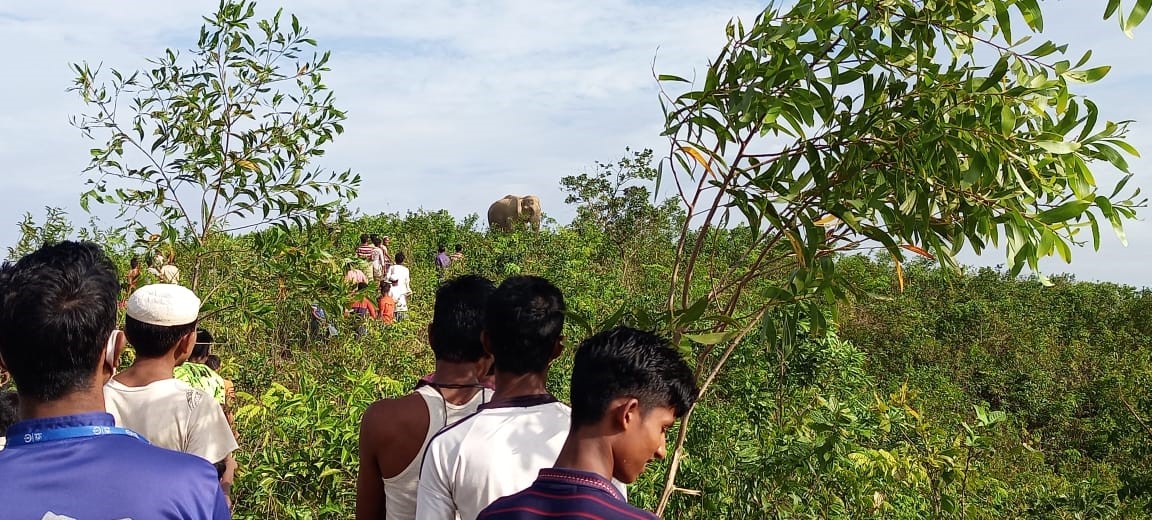St. Martin’s Island and its unique biodiversity face serious threats
To mark the occasion of the International Year of Biodiversity 2010, a Movement to Save St. Martin’s Island, an ecologically critical area in Bangladesh, was organized by an IUCN member Coastal Area Resource Development and Management Association (CARDMA).

Photo: CARDMA
CARDMA presented a report at a Press Conference on Tuesday March 2, 2010 at 3:30 PM at Press Club on: Post COP 11 Initiative: Coastal cleanup and public awareness on biodiversity conservation, sustainable development and adaptation to climate change in Cox Bazar and St. Martin's Island as a part of observing International Year of Biodiversity. Similar programmes will be taken up in other ecologically critical areas in coastal area.
CARDMA team has just returned from St. Martin’s Island and has found that the island and its unique biodiversity face serious threat due to recent human interventions in the island. An exhibition of paintings by children in Cox Bazar and St. Martin’s was displayed.
The team included members and representatives from CARDMA, BELA, WEAB, Narikel Jinjira Poribesh Club, and St. Martin’s High School, Arjo Cholochitra Foundation, artists from Charukala Institute and others. Mr. Lutfor Rahman Kajol MP of Cox Bazar addressed the rally and took part in the mass awareness programme. The chairman of Union Parishad and local leaders pointed out the various socio economic problems. The day long programme was also participated by a good number of tourists, local residents and children.
It was very obvious that the island has lost its capacity to hold so many tourists and hotel and shipping related activities. Ever increasing population and careless tourism has been pointed out as number one problem which is putting a lot of stress on the resources of the island and on the fragile coral ecosystem which shelters a diverse variety of marine biodiversity which is not found anywhere else in Bangladesh.
St Martin’s Island includes a cluster of islands. To save coral islands which benefit us in so many ways, the governments of the world must reduce carbon dioxide emissions and create more marine parks.
Scientists have said that St. Martin’s is getting smaller every year instead of growing geologically as it should. The increasing cyclones and erosion of coral are held responsible. If St. Martin’s vanish what will happen to its population we do not know. As sea turtles die in numbers it is an indication that all is not well.
Coral reefs are particularly susceptible to human activities because most corals reefs occur in shallow water near shore where human impacts are the greatest.
Threats from human activities include:
1. Oil pollution and heavy metal pollution
2. Sewage and chemical pollution from fertilizer runoff lead to coral destruction. At present most sewage from hotels is piped into the sea.
3. Constructions of buildings and hotels.
4. Algae and sea grass removal
5. Mangrove, sand dunes and hills are being cut down and destroyed.
6. The island dependent on generators produces heavy pollution and continuous loud sound which threaten marine life.
7. Over fishing, destructive fishing practices including use of cyanide and dynamite. The sea is often invaded by foreign fishing trawlers. The fishing net catches turtle and instead of freeing them which is cumbersome the turtles are killed.
8. Coral extraction under sea for building materials and for souvenir trade
9. Ocean warming and rising carbon dioxide. Global warming increases temperature in the sea and harms zooxanthellae algae on which hard corals depend.
10. Loss of habitat and sanctuary for marine life dependent on the island’s ecosystem.
11. Scarcity of drinkable water for local people and fresh water for ecosystem survival
12. Sedimentation due to construction, farming and deforestation blanket the coral reefs, smothering the coral resulting in blocking the sunlight required for photosynthesis by the symbiotic algae.
13. Trash in water cause destruction of the reefs by blocking sunlight. Sea turtles and other marine animals may eat plastic taking it for jelly fish eventually die. Discarded fishing nets snag on the reefs and strangle thousands of marine life.
It was noted that buying and selling land has pushed the price of limited land up. Valuable mangrove and hills have been cleared and cut down for holiday cottages or hotel purpose. Recent environmental requisites have not been well coordinated or explained to the people. While Shipping ministry and Tourism ministry tend to encourage tourism, the government now needs to come up with special policy for St. Martin’s and implement it.
The role of Coast Guard is to defend the sea and to implement UN Law of the Sea Convention which Bangladesh has signed and ratified. To defend the last frontier of Bangladesh and to uphold Bangladesh’s right to deep sea, St. Martin’s has to be saved, it was emphasised. The Coast Guard should be strengthened and given more power to implement the clauses in the Convention.
CARDMA’s ultimate aim is to try to preserve coastal marine biodiversity, adaptation to climate change, keeping destructive human interventions at a minimal, reduction of poverty of the people and preserving its ecosystems and biodiversity for our future. CARDMA calls upon the government to take legal measures to save the island and to regulate tourism and ensure coordination among various ministries and agencies.
Help us save our icon the Pacific Reef Egret, one of the rarest birds in the world.
CARDMA is a member of IUCN which was founded in 1987, and endeavours to promote sustainable and integrated development and the conservation of marine and coastal ecosystems.
For more details, please contact:
Hasna J Moudud
UNEP Global 500 Roll of Honour For Environmental Achievement
President CARDMA
cleanwater07@gmail.com



